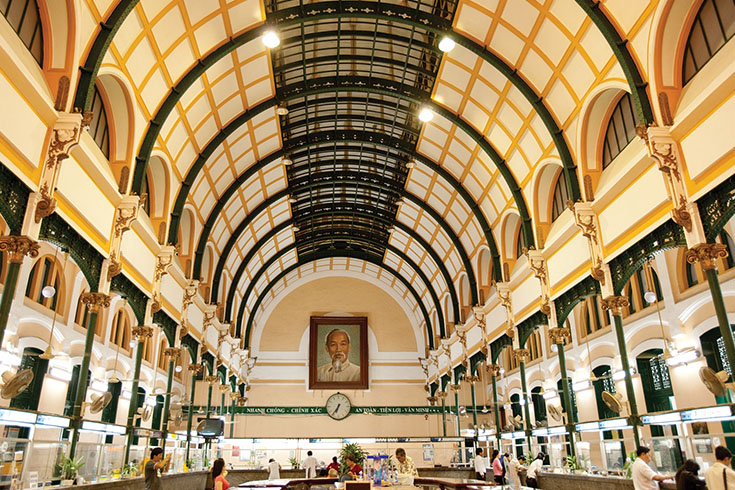I. Legend and History of Thien Hau Pagoda
Thien Hau pagoda was built by a group of Chinese immigrants around 1760 and was restored many times. The pagoda is located in the central area of the first Chinese center which is the area of Cho Lon today.
According to scholar Vuong Hong Sen, Thien Hau Thanh Mau (the main worshiped god in the pagoda) is named Lam Mac Nuong. She was born on March 23rd, 1044, under the reign of King Tong Nhan Tong. Then, at the age of eight, she could read, at eleven she became a Taoist practitioner. At the age of thirteen, she was blessed by the God and received God’s poem, then followed that to practice enlightenment.
Once, her father and 2 brothers was on a boat carrying salt to Jiangxi province to trade, a big storm came … At that time, she was weaving cloth next to her mother at home, but she was suddenly out of spirit to go to save her father and brothers.
She used her teeth to keep her father’s shirt, while her hands held her brothers. At that moment her mother called her and forced her to answer, so she had to open her lips to answer, which made the waves sweep away her father, and she could only only saved the two brothers. Since then, every time when the boat is in distress at sea, people called her. In 1110, the Song Dynasty ordained her “Thien Hau Thanh Mau”.
II. Structure and Architecture of Thien Hau Pagoda
1. Outside
Thien Hau pagoda is built according to the “seal” style a typical architectural style of the Chinese people. This is a combination of 4 linked houses forming a ground like the word “mouth” or the word “nation” (in Chinese). There are 3 rows of houses in the middle which are the front hall, middle hall and back hall. Between these rows of houses, there is a space called the “Thien Tinh” (sky well), which helps the pagoda space to be airy, make enough light for the back hall help escape the smoke of incense.
All the halls are decorated with flowers and birds patterns, along with the parallel sentences which is usually red and yellow to create warmth and trust for the visitors. The pagoda also has a 4-in-a-row continuous painting which depicts the animals of the “four spirits”. The pagoda is also embellished by the round statues and dense ceramic reliefs on the roof, porch, altars and the walls …
2. Inside
In the main hall which is called Thien Hau Cung, the statue of Lady Thien Hau is placed in the middle, while the two sides worshipped Kim Hoa Nuong Nuong (right side) and Long Mau Nuong Nuong (left).
The statue of lady Thien Hau was carved from a 1-meter high wooden block, long before the construction of the pagoda. It was worshiped in Bien Hoa first and then moved here in 1836. The two statues on the side are made of colored hard paper. All the statues are dressed in splendid embroidery. The auxiliary room is located on two main sides of the shrine of Quan Thanh, Jizō, and Than Tai.
In addition, the pagoda also has about 400 antiques, including 7 statues of deities, 6 stone statues, 9 steles, 2 small bells, 4 bronze incense burners, 1 stone incense burner, 10 diaphragms, 23 opposite sentences and 41 embossed painting … All these antiques are carefully crafted, meticulously with delicate lines.
3. Highlights
The highlight of Ba Thien Hau pagoda is the unique pendant hanging overhead. Visitors can buy rings, record their wishes or wishes on paper, then hang it up with am incense stick to plead with Mrs. Thien Hau.
Another special highlight of the temple is that all materials are imported from China, from precious woods to incense bowls, from reliefs to figurines,…. That partly shows that Ba Thien Hau pagoda is very important in the life of the Chinese people in Saigon.
III. Religious Activities in Thien Hau Pagoda
Everyday, Thien Hau Pagoda welcomes a lot of people come to pray for safety, prosperity… However, the most crowded times are the first and full moon days of each month and the Chinese New Year holidays. Especially, Ba’s Day (March 23rd lunar calendar) is considered the main festival of the pagoda.
On this day, many Chinese and Vietnamese people come to the pagoda to worship Lady Thien Hau. Right from the previous night, “Ba” bathing ceremony was held at the pagoda. In the morning of the 23rd, people hold the Lady procession ceremony: The statue of Lady Thien Hau would be placed in a palanquin, carried by young men and women dressed beautifully and parade through the streets around the pagoda. Following the palanquin, there are dragon boats, red boards with the names of the gods worshiped in the pagoda, dance teams which include: lion dance, dragon dance. Along with that, there would be ethnic music performances. creating a bustling scene in the neighborhoods around the pagoda.
IV. Extra Tips on Visiting Thien Hau Pagoda
Since it’s a religious and quiet place, you should not wear the summer type, revealing outfits like tank tops, tennis skirts and shorts,… The best option is plain and simple jeans and T-shirt, which makes it more comfortable for you to explore, while still showing your respect for the place.
Lady Thien Hau pagoda is one of the oldest historical pagodas of the Chinese people in Ho Chi Minh City. Besides the value of architectural art, sculpture and ancient artifacts, this place is also a place for gathering and mutual support of Vietnamese people of Chinese origin (Cantonese).
The story of Mrs. Thien Hau, through the teller, sometimes there are some differences, but mainly it is to promote a Chinese woman with filial piety, virtue, daring to sacrifice herself for everyone … educational purposes.

.jpg)






.jpg)







